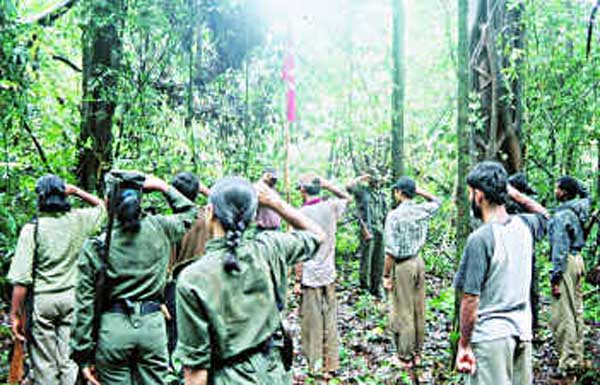A pair of shoes and socks left neatly in a hollow in the jungle floor has become the leitmotif of neglect, incompetence and a glaring ignorance of how the pervasive “Left Wing Extremism” should be tackled in Chhattisgarh and contiguous central and southeastern states of India.
The malaise exists from the level of the ‘boots on the ground’ (as illustrated above after the April 24, 2017 Sukma attack in which Maoist rebels killed 25 security personnel in an ambush) through the absentee head of the Central Reserve Police Force (who was appointed only after two massacres had happened) and a state government that is allergic to advice from one of the great architects of counter-insurgency in India — K.P.S. Gill of the Punjab Police.
What was Gill’s advice after the massacre in Bastar in May, 2004 when Congress veteran (with a brief BJP fling) Vidya Charan Shukla and 24 other political leaders were gunned down in an ambush in Chhatisgarh? He had advised the state government to “go back to the basics” of counter-insurgency operations.
What are the ‘basics’ of counter-insurgency? The first and foremost is that it is a manpower-intensive operation. An inverse reading of the works of the arch-priests of guerilla warfare — Mao Zedong of China and the charismatic Latin American Ernesto ‘Che’ Guevara — put the numbers required by the state to neutralise one guerilla fighter as a ratio of 50:1 (i.e. one guerilla fighter can tie down 50 security personnel depending on the local conditions of geography, demography and social development.) In the Malayan counter-insurgency operations Britain managed to contain the movement with a ratio of 20 security personnel to one guerilla fighter.
Given that there are persistent reports that the Maoists have been able to deploy as many as 300 fighters in the Sukma-Bastar salient (considered to be their stronghold), it should be the endeavour of the state and central governments to deploy a favourable ratio of security forces. This could be a minimum of 3,000 personnel, the larger proportion being policemen.
The underlying logic of this proposition is that the state should be able to show “presence”. Presence, particularly of state police forces, backed by adequately armed paramilitary forces (like the Central Reserve Police Force) makes for an infrastructure of human intelligence (humint) networks that, if properly handled, would have, in the latest incident, indicated that Maoists were active in that particular area. That knowledge, if it had been conveyed to the road-opening party, would have ensured that they would have been more alert (and the soldier who had taken off his shoes and socks to give his tired feet some rest would not have done so).
The concept of “road opening parties” is fraught with ambuscades. If security forces withdraw to their barracks at night they leave a vacuum in the area of their deployment which is sought to be reclaimed by another “road opening party” the next morning.
In the meanwhile, the night belongs to the guerilla fighters. They are free to lay improvised explosive devices and prepare the ground to set up an ambush. How well they have managed to mould the battlefield can be seen in the manner in which they have tackled the behemoth “mine-resistant vehicle” imported from South Africa. They have discovered that the vehicles can withstand only up to 15 kg of explosives. So they plant IEDs of 50 kg and blow up the Casspir Mine Resistant Vehicles like matchboxes.
In the March 11 ambush near Bheji in the same area, the Maoists displayed amazing skill in the deployment of IEDs. While trying to escape the series of explosions in the first frontal attack, CRPF personnel ran into a second bank of IEDs placed along the path the Maoists had forced the troops to take in a classic operation of “moulding the battlefield”.
While it is true that state governments have made efforts to increase the number of policemen and CRPF has also done the same but the reality on the ground has hardly changed. Instead of “rushing troops to the spot” after the event, the state government must ensure a police/security patrol party every five kilometres of the road under protection so as to ensure quick response to any Maoist activity in the area.
It has been suggested that drone aircraft be used to conduct surveillance in the Maoist stronghold. It will help only if there is enough manpower available to respond to the detected threat.
Because of the threat from mines (and the effect on the mine-resistant vehicles) K.P.S. Gill’s advice is that the security forces should walk.
To this should be added the discovery published by the Indian Army’s Remount and Veterinary Corps pamphlet in the late 1950s lauding the sight and smell capabilities of canines and their use to the military. An integral dog squad with every patrol party will at least indicate the presence of other human strangers in the locality, thereby providing an early warning signal to the whole patrol party.
Military dogs are force multipliers in a counter-insurgency/counter-terror operation. Their population in both the police force as well as the para-military like the CRPF should be increased in keeping with the experience gained about their special requirements in the rural setting.
K.P.S Gill was appointed Advisor to the government of Chhattisgarh in the mid-2000s. The Chief Minister was the same. The Maoist threat remains the same. His advice has fallen on deaf ears.





